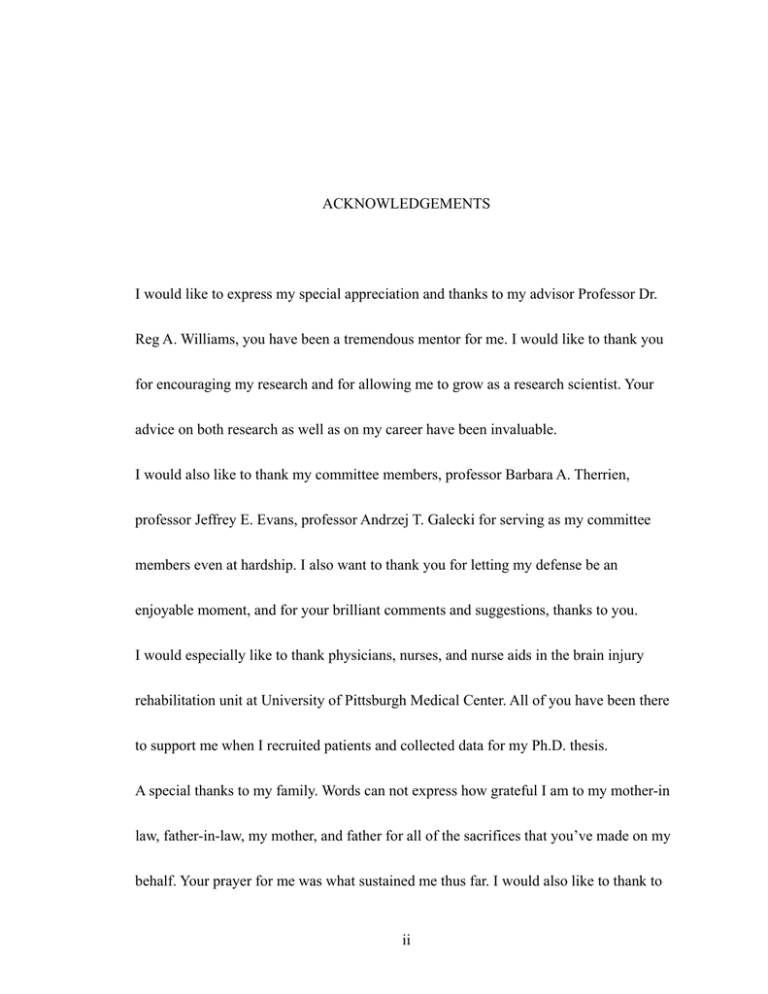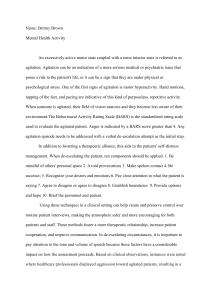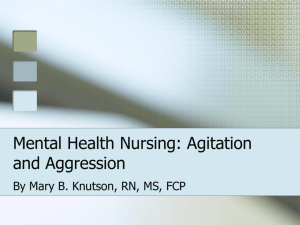ACKNOWLEDGEMENTS I would like to express my special
advertisement

ACKNOWLEDGEMENTS I would like to express my special appreciation and thanks to my advisor Professor Dr. Reg A. Williams, you have been a tremendous mentor for me. I would like to thank you for encouraging my research and for allowing me to grow as a research scientist. Your advice on both research as well as on my career have been invaluable. I would also like to thank my committee members, professor Barbara A. Therrien, professor Jeffrey E. Evans, professor Andrzej T. Galecki for serving as my committee members even at hardship. I also want to thank you for letting my defense be an enjoyable moment, and for your brilliant comments and suggestions, thanks to you. I would especially like to thank physicians, nurses, and nurse aids in the brain injury rehabilitation unit at University of Pittsburgh Medical Center. All of you have been there to support me when I recruited patients and collected data for my Ph.D. thesis. A special thanks to my family. Words can not express how grateful I am to my mother-in law, father-in-law, my mother, and father for all of the sacrifices that you’ve made on my behalf. Your prayer for me was what sustained me thus far. I would also like to thank to ii my beloved husband, Dr. Donghyun Lee and my sister, Dr. Sukyung Park. Thank you for supporting me for everything, and especially I can’t thank you enough for encouraging me throughout this experience. To my beloved daughter Joyce Juhee Lee, I would like to express my thanks for being such a good girl always cheering me up. Finally I thank my God, my good Father, for letting me through all the difficulties. I have experienced Your guidance day by day. You are the one who let me finish my degree. I will keep on trusting You for my future. Thank you, Lord. iii TABLE OF CONTENTS ACKNOWLEDGEMENTS --------------------------------------------------------------------- ii LIST OF TABLES -------------------------------------------------------------------------------- v LIST OF FIGURES------------------------------------------------------------------------------- vi LIST OF APPENDICES ------------------------------------------------------------------------ vii ABSTRACT-------------------------------------------------------------------------------------- viii CHAPTER I. INTRODUCTION---------------------------------------------------------------- 1 CHAPTER II. REVIEW OF LITERATURE------------------------------------------------- 12 CHAPTER III. METHODS-------------------------------------------------------------------- 46 CHAPTER IV. RESULTS---------------------------------------------------------------------- 62 CHAPTER V. DISCUSSION------------------------------------------------------------------ 81 APPENDICES----------------------------------------------------------------------------------- 97 BIBLIOGRAPHY----------------------------------------------------------------------------- 109 iv LIST OF TABLES Table 2.1 Literature Review of Agitation Prevalence -------------------------------------- 17 3.1. Randomization of Group Assignment with 14 Subjects ----------------------- 47 4.1. Clinical Characteristics of Each Patient in Group A ---------------------------- 63 4.2. Clinical Characteristics of Each Patient of Group B --------------------------- 64 4.3. Preferred Music Selections Used for Each Patient in Group A --------------- 65 Preferred Music Selections Used for Each Patient of Group B -------------- 65 4.4. Results of the Mixed Model ANOVA for comparing Group A and Group B 67 4.5. Repeated Measure ANOVA with LSD on All 4 Components of ABS (Preferred Music) -------------------------------------------------------------------- 75 4.6. Mean ABS scores of the Cognitive Component and Physical Component in the ABS During the Preferred Music Intervention --------------------------- 76 4.7. ABS Scores of All Patients --------------------------------------------------------- 79 v LIST OF FIGURES Figure 1.1. Model of preferred music and agitation after TBI -------------------------------- 7 2.1. Antecedents, attributes, and consequences of agitation after TBI ------------- 34 3.1. Time frame of music intervention ------------------------------------------------- 57 4.1. Mean ABS scores for preferred music (error bar = standard error of the mean) ------------------------------------------ 69 4.2. Mean ABS scores for classical “relaxation” music (error bar = standard error of the mean) ------------------------------------------ 71 4.3. Changes in mean of ABS scores for preferred music and for classical “relaxation” music ------------------------------------------------------------------ 73 4.4. Trend of individual data for preferred music ------------------------------------ 77 4.5. Trend of individual data for classical “relaxation” music intervention ------ 78 vi LIST OF APPENDICES Appendix A. INSTRUMENTS----------------------------------------------------------------- 97 B. INFORMED CONSENT ------------------------------------------------------103 vii ABSTRACT Background: Agitation after Traumatic brain injury (TBI) is a common behavioral problem which threatens the safety of patients and caregivers, disrupts the rehabilitation process, and becomes a major stress on caregivers. Preferred music as an environmental intervention can reduce agitation by inducing positive memories and emotions and relaxation in a patient. Purpose: The purpose of this study was to evaluate the effects of preferred music intervention on agitation for patients after TBI compared to those of classical “relaxation” music intervention. Methods: The study was a crossover design within subjects using a non-probability and purposive sampling method. The sample consisted of 14 patients from the acute rehabilitation unit in the University of Pittsburg Medical Center (UPMC) who suffered from cognitive impairments after severe brain injury and exhibited agitated behaviors. Subjects were divided into two groups. The first group listened to classical “relaxation” music first and then to preferred music. The second group listened to the music in reverse viii order. The scores of the Agitated Behavior Scale (ABS) were calculated in 1 hour increments (i.e., one hour before and immediately after listening and then one hour later). Data were analyzed using a mixed model ANOVA, a repeated measures ANOVA and a ttest. Results: There was a significantly greater effect of preferred music intervention compared to the effect of classical “relaxation” music (p= .046). The preferred music significantly reduced agitation (p= .01) while the classical “relaxation” music did not (p= .76). In particular, the patients’ physical agitation (p= .006) and cognitive agitation (p= .008) were significantly reduced after preferred music intervention. Conclusion: According to the findings, preferred music has a potential to provide therapeutic approaches for care of agitated patients after TBI. Additionally, positive effects of preferred music on agitation can give health care providers and patients’ family members motivation to explore more familiar environments for managing agitation. ix




